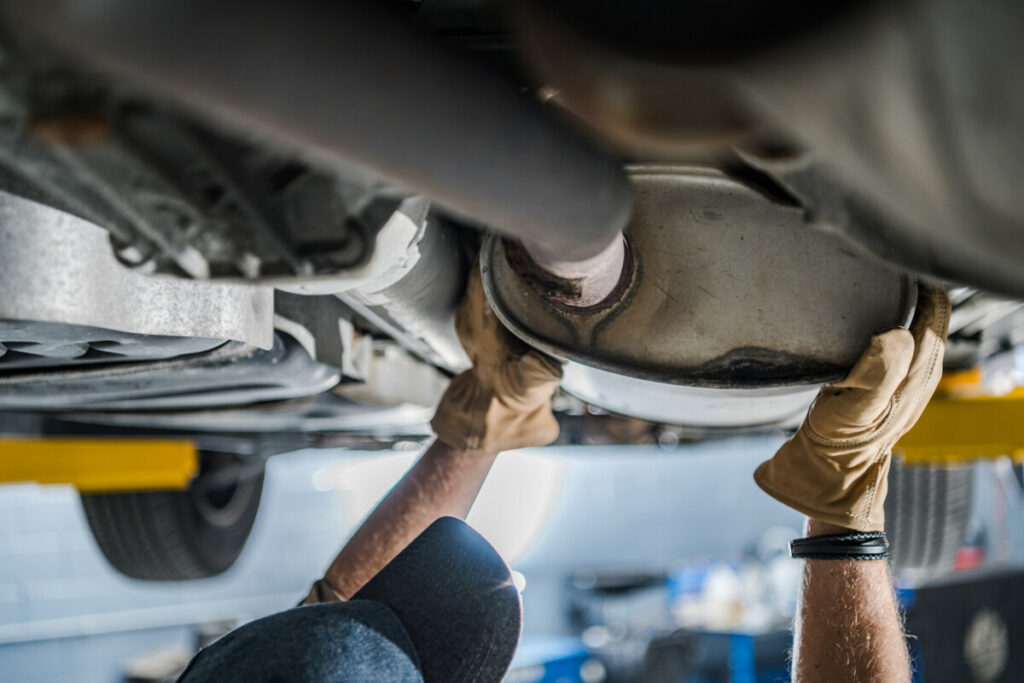A visit to your mechanic can be due to many reasons. One of those reasons is when your catalytic converter goes bad. Today, we’ll be seeing if you can drive with a bad catalytic converter. Before we answer your question, let’s see what the catalytic converter does, what the symptoms of a bad catalytic converter are, and what’s the cost of repair.
Can I Drive With A Bad Catalytic Converter?

Technically, yes. But is it a good idea? No. If your catalytic converter doesn’t work properly and has a clogged-up oxidation or reduction catalyst, it won’t allow for proper exhaust flow. Bad gasses will build up in the catalytic converter’s chamber and with the backpressure caused by the density of gasses, come back to the engine. This can cause serious damage to the engine over a prolonged period. If you got to get somewhere, you can. Just be sure to resolve the issue before it causes permanent damage.
Also Read: Is Getting A New Engine Like Getting A New Car?
What Does The Catalytic Converter Do?
For your car to create energy, it burns fuel. And the result of burning fuel is toxins such as carbon monoxide and nitrogen oxide. The catalytic converter’s role is to filter out these toxins into less harmful byproducts such as water vapor, carbon dioxide, and nitrogen. Basically, the catalytic converter reduces the harm your car creates to the environment.
How Does The Catalytic Converter Work?
The catalytic converter takes the harmful gases through a pipe, it then changes the compositions of the harmful gases making them less harmful. It does this in its chamber, where you can find a reduction filter that eliminates nitrogen oxide, and an oxidation filter that eliminates carbon monoxide. After the process is finished, the byproducts come out of the other pipe as water vapor, carbon dioxide, and nitrogen.
What Is The Structure Of The Catalytic Converter?
The catalytic converter consists of:
- Intake pipe that takes in the harmful gases from the burning fuel;
- Heat shield that protects the car parts around the catalytic converter from absorbing the heat it creates;
- Converting chamber which is stainless steel;
- Oxidation and reduction catalysts/filters inside the chamber that are made of catalytic active material;
- Exhaust pipe which sends out the now harmless byproducts.
How Do I Know If My Catalytic Converter Is Bad?
You can tell if your catalytic converter is going bad in many ways. One of the main symptoms is dark exhaust smoke. You can test this by having someone behind your car look at the exhaust while you’re pressing the gas pedal. Another symptom is worsened performance, mainly when accelerating. Weird smells can also indicate a damaged catalytic converter, and heat coming from under the car is a sign too. Your gas mileage will worsen since your exhaust flow isn’t working properly. On average, catalytic converters last about 10 years.
What Damages The Catalytic Converter?

Catalytic converter damage usually occurs when the fuel-air mixture isn’t right in the combustion chamber of the engine. This sends the gasses in a different state than the catalytic converter is meant to resolve, and causes it to clog up. Bad spark plugs can also cause irregularity in the fuel-to-air ratio, and a damaged oxygen sensor can too since its purpose is to find the best fuel-air mixture for your car. This can stuff the catalytic converter, raise its temperature because of the overwork, and ultimately, melt it.
Fixing The Catalytic Converter
Swapping It
A catalytic converter fix isn’t necessarily cheap. The item itself can cost anywhere between 300$ and 2500$, and the labor price ranges from 70$ to 130$, depending on how hard it is to access. This is obviously the best option if you have the budget, though you must check if there are any air-to-fuel ratio issues that may damage your new catalytic converter too.
Repairing It
If the damage is minor, and your catalytic converter is not too clogged up, you may be able to get away with just cleaning it. If you have the skill yourself, you can take out the catalytic converter, rinse it in hot water, use fuel additives to thoroughly clean it, pressure wash it, and put it back in place. You should also know that you have to take out the oxygen sensor when removing the catalytic sensor, and put it back in when installing the catalytic sensor. If you can’t do this process yourself, ask your mechanic and just do the cleaning.
Other Underlying Issues
As we mentioned before, the catalytic converter usually gets damaged because of an inappropriate fuel-air mixture. This means that the oxygen sensor, EC, spark plugs, or other components around the combustion system may be damaged. You need to check these out before buying a new catalytic converter since it might get damaged right away if you don’t have these sorted.
Also Read: The Benefits of Ventilated Seats
Conclusion
To answer your initial question is no hard task. You can drive with a bad catalytic converter if you eventually want to throw away your engine that is. After diagnosing the issue, get to your destination and make sure to swap it or repair it as soon as possible. It won’t create surrounding damage when it’s in its early deteriorating stages, so you can drive it if your mechanic schedules your fix in say a week, though soon enough it will.

